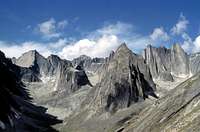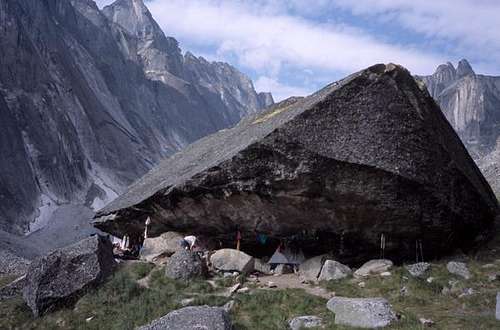|
|
Area/Range |
|---|---|
|
|
61.59072°N / 127.51831°W |
|
|
Trad Climbing |
|
|
Summer |
|
|
5300 ft / 1615 m |
|
|
Overview
The "Cirque of the Unclimbables" is the name of a group of stunning granite peaks located near the border of Canada's Northwest Territories and Yukon Territories in the Ragged Range, a remote region of the Logan Mountains. The Cirque itself sits just inside the border of the Northwest Territories and just outside the border of Nahanni National Park. The Cirque contains one of the most well known and aesthetic alpine rock climbs found anywhere in the world - the Lotus Flower Tower (LFT). The LFT was perhaps made famous by its inclusion in Steck and Roper's book "The 50 Classic Climbs of North America"; however, it is likely it would have gained similar popularity regardless. The Cirque is also home to Mount Proboscis, an impressive piece of rock in its own right; and also containing some fine hard long free routes (including Todd Skinner's "Canadian Knife"). The area was first visited in 1955 and at that time was given the name the "Cirque of the Unclimbables" because of the sheer size and steepness of the granite spires - they appeared unclimbable. Of course, over the years all of the peaks in this area have been climbed by their easiest lines, as well as difficult climbs right through terrain that was thought "unclimbable" 50 years ago.
Getting There
Getting into the Cirque is a bit of a challenge, but is nothing too intimidating. First you have to get yourself to Northern Canada (either the Yukon or Northwest Territories). The company you decide to fly into the Cirque with will help determine where you need to get to first. For most people (except for perhaps some western Canadian climbers or folks who like a really long drive) it makes the most sense to fly to Northern Canada, landing in the Yukon city of Whitehorse. Currently, Air North and Air Canada have the only scheduled flights into Whitehorse (see this link for flight information). From here you can rent a vehicle (recommended) and drive to your designated meet-up location with the float plane you have chartered. It is also possible to get picked up in Whitehorse and be driven to your floatplane departure location, or alternatively a plane can be chartered to fly you from Whitehorse to your floatplane; however, both of these options are more expensive than renting a vehicle.
Booking a floatplane to fly you and your gear to Glacier Lake (the starting point for most trips into the Cirque) is the first important decision you will have to make. I'm going to provide (up-to-date) contact information for each of the flying services that I know of that will fly climbers into Glacier Lake; however, I'm going to recommend one company "Kluane Airways", based on my experience as well as others that have gone before and after me.
Kluane Airways Ltd
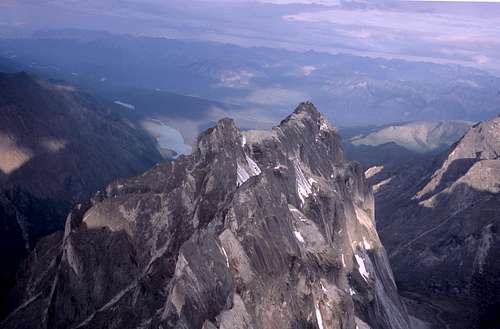
The view from the floatplane flying over the Cirque of the Unclimbables - the peak you can see is Mount Harrison Smith and the lake is Glacier Lake (this is where you land). The Nahanni River can also been seen in the background.
Box 29008 OK Mission RPO
Kelowna, British Columbia
V1W 4A7
Phone: 1-250-860- 4187
Fax: 1-250-860-8894
Website: http://www.kluaneairways.com
Email: info@kluaneairways.com
Wolverine Air Ltd.
P.O. Box 316,
Fort Simpson, Northwest Territories
X0E 0N0
phone: 1-867-695-2263
Toll free: 1-888-695-2263
Fax: 1-867-695-3400
Website: http://www.wolverineair.com
Email: info@wolverineair.com
Charter info: info@wolverineair.com
Simpson Air Ltd.
Box 260
Fort Simpson, Northwest Territories
X0E 0N0
Phone: 1-867-695-2505
Toll free: 1-866-995-2505
Fax: 1-867-695-2925
Website: http://www.simpson-air.com
Email: info@simpsonair.ca
Watson Lake Flying Service
Box 7
Watson Lake, Yukon
Y0A 1C0
phone: 1-403-536-2231
Fax:1-403-536-2399
Kluane Airways makes sense for climbers wanting to experience the raw beauty and adventure of the Cirque. Here's why:
1. Warren LaFave, the owner of Kluane Airways, has a vast amount of experience shuttling climbers into and out of Glacier Lake. Warren has been flying people into the Cirque for more than 15 years. This company is used to dealing with climbers and the sometimes special circumstances that this entails.
2. Kluane Airways is based out of Finlayson Lake (about 150 miles north of Watson Lake) - they are also a partner in a luxurious fly-in fishing resort called the Inconnu Lodge located on the nearby McEvoy Lake. It is from Finlayson Lake that you will begin and end you flight into the Cirque. Kluane Airways offers numerous options around arriving at their Finlayson Lake base. Kluane Airway can pick you up at the airport in Whitehorse and drive you to the base, they can arrange a chartered aircraft to fly you directly from Whitehorse to their Inconnu Lodge, or you can drive in your own vehicle or a rented vehicle and meet them at their Finlayson Lake base. The cheapest option is to either rent a vehicle at the Whitehorse airport or drive your own vehicle.
3. Besides flying into the Cirque, Kluane Airways offers a full range of other services. They will book hotels and chartered flights through their office, and if anyone loses gear on route they have a good deal of climbing equipment, camp stoves, camp stove fuels, tents, foam mattresses and food that they can provide you.
4. Once you arrive at Finlayson Lake, Kluane Airways offers a number of different options for flying into the Cirque:
1) You can fly via a Dehavilland Beaver floatplane into Glacier Lake and then hike from there into the Cirque (the cheapest option) - limit of four passengers and 1200 pounds
2) You can fly via helicopter directly into the Cirque, thereby missing the hiking experience (the most expensive option) - limit of two passengers and 600 pounds.
3) You can use a combination of the float plane and helicopter. Two climbers fly directly into the Cirque via helicopter, then they shuttle via helicopter the remaining 2 - 4 climbers who have arrived at Glacier Lake via float plane. This is still quite expensive.
However, putting aside the fact that Kluane Airways has the best price, the most options, and the most experience, perhaps the main reasons to fly with Kluane are these:
A. Once at the Finlayson Lake base, if there is poor weather and they are not able to fly you into the Cirque, they will overnight you at their Finlayson Lake cabin or fly clients into Inconnu Lodge to overnight. This gives your party a place to hang out until the weather clears up. Meals and accommodations at Inconnu Lodge are complimentary of Kluane Airways Ltd.; however, if you end up staying too long they will put you to work (don't worry it's a more than fair trade off). Check out their Inconnu Lodge Web Site, you may end up praying for bad weather.
B. And to top it all off, you get a complementary night at the Inconnu Lodge on your trip out. Believe me, there is nothing that feels as nice as spending a night at this 5-star resort, after living in a tent for two or three weeks.
C. Kluane Airways also supplies at no cost to climbers a satellite phone that is located at the Cirque. You can phone their base anytime to change your pick up flight or to call in case of an emergency.
When and How Long?

The Dehavilland Beaver floatplane and pilot Warren LaFave dropping us and our gear off at Glacier Lake - from here it's a grueling 8 hour hike into the Cirque of the Unclimbables.
For climbers visiting the Cirque for first time, a big question that must be answered is - when should I go and how long should I stay? The best weather for climbing in the Cirque is in July and August. The last week in July and first two weeks in August probably give you the best combination of potentially warm weather and long days. As far as how long of a trip you should plan - probably a minimum of two weeks, preferably three. The weather in the Cirque is notoriously bad - when I was there we had about 4 days of decent weather to climb out of 20; and only one of those days was it truly nice (the day we left). If you're going to undertake the big effort (and expense) required to get to the Cirque, you might as well give yourself a decent chance of climbing something by ensuring you're there long enough to get a weather window. The days are long this far north in the summer time, so you will have daylight for 16 -20 hours a day in July and August.
The Hike In
If you can't afford the helicopter trip (like most of us), then you'll end up at Glacier Lake looking at your huge pack, and the daunting talus slope you're going to have lug that sucker up. Don't believe anyone who might tell you the hike in isn't that bad - trust me it sucks. Your main choice is to decide how you want to do it - there are essentially two options:
1. Hump the whole load up there at once,
2. Do the trip twice with smaller loads
I choose option one and I'm still not sure that was the right option. Either way, it's a long tiring day - expect 7-10 hours, much of it on loose, soul sucking, talus. Even though we had been thoroughly warned not to climb up (or down) the right side of the approach slope (because it was vegetated and not talus), two of our party tried it anyway. They retreated with their tail between their legs. So I'll tell you again - as ugly as walking on the talus seems - it's better than the thick relentless vegetation that border the talus slope.
There is a faint trail that leaves from the Glacier Lake drop off point heading up the river toward the talus slope below Mount Harrison Smith. Be sure to cross the major stream crossing that exits the Cirque before heading up the talus slope. There is a log crossings, but be careful you wouldn't want to slip here. We split up our load to take it across this crossing in two lighter (i.e. more balanced) carries.
Once on the talus slope, it's up to you to decide how to best manage it - there are cairns from time to time, but they don't always make sense. In general you want to exit up near the base of Mount Harrison Smith on the right side of the talus slope.
Once you break over the rise and see the Cirque for the first time, all the pain will be worth it - it won't be forgotten, but it will be worth it.
Camping
The Cirque is a beautiful fragile place, and all camping must be carried out with respect for the land. Camping should be limited to "Fairy Meadows" a relatively flat bouldery meadow located in the right stream fork of the Cirque just up from where this stream joins the left fork stream. Try to camp in established campsites - there are a couple of primo camp spots that are located near or under huge boulders. When I was there we never even used a rain-fly, because we pitched our tent under the overhang of a gigantic boulder. In 2000, a pit toilet was installed at Fairy Meadows to help address a looming human waste issue in this delicate ecosystem. There are also bear-proof containers at the main camping areas to store your food in.
In order for the Cirque to continue to offer a true wilderness experience for all, visitors in should adhere to the following Wilderness Code of Ethics:
Proper Disposal of Refuse: "Pack it in, pack it out". All non-burnable garbage should be packed-out. Paper products should be burned in a contained area on bareground or packed-out.
Proper Disposal of Human Waste: When at basecamp, use the pit toilet located in Fairy Meadows. Avoid throwing your toilet paper or trash in the toilet. Toilet paper should be bagged-out or burned in a contained area on bareground. When away from basecamp, waste should be buried more than 50 meters away from a water source or smeared on a rock. Climbers should contain their waste on routes. Waste may then be disposed ...
Proper Wash/Waste Water Disposal: Recognizing the seasonal nature of some surface water runoff, please perform washing and disposal of gray water at least 50 meters away from any water source.
Treat All Drinking Water: There is potential for water contamination due the presence of mammals such as arctic ground squirrels, mountain goats and other humans in the Cirque. Therefore, it is suggested that all drinking water be filtered, boiled, or treated.
In addition to the requirements above, the following should also be considered when visiting the Cirque:
Tread Lightly: When hiking in the vegetated valleys of the Cirque, please make an effort to stay on main trails. The trail going up to the Cirque is marked with rock cairns (piles) and the main trails entering/exiting Fairy Meadows basecamp are obvious. Staying on these trails will help preserve the fragile arctic plant communities.
Proper Bear Safety: Grizzly bears (Ursus horribilis) are present at lower elevations, while nearly nonexistent above treeline. Please take the following precautionary measures when camping below treeline:
1)Secure all food on a "bear line" at least six meters off the ground and at least 50 meters from your campsite.
2)Avoid leaving food materials uncontained and make sure your campsite is free of cooking utensils.
3)Let bears know where you are when hiking through thick forest by frequently making noise (i.e. avoid being silent when hiking below treeline).
Proper Use of Satellite Phone: Kluane Airways has generously provided a satellite phone for emergency use during the summer season. Please, only use this phone in the event of a life threatening injury. Instructions for phone use are contained within the phone box. Please read all instructions carefully before using. Note: this phone is only present when at least one of Kluane Airway's parties is in the Cirque.
Ground Squirrels - These little rodents are truly diabolical; if you leave any food out for a minute, it will be gone. Don't throw rocks at them - you might hit your own tent and make a hole in it (yes, I'm speaking from experience here).
Bouldering and Sport Climbing in the Cirque?
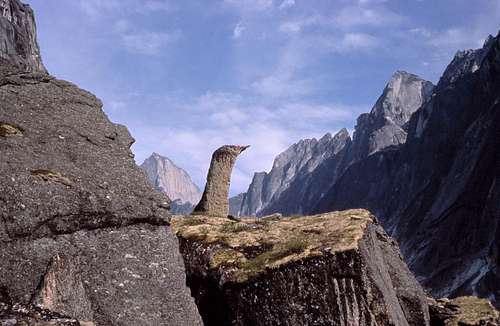
This is one of the coolest looking boulders I've ever seen - it's called "The Penguin". There are a number of climbs on this boulder including one that goes up the stomach and ends right on the beak.
What you say? - I travel almost to the North Pole and I can't get rid of these skinny sport climbers and boulderers? Yes it's true; there is a whole plethora of sport climbs located on the numerous huge boulders located around camp - ranging from 5.8 warm ups to 5.13. The bouldering there is also phenomenal - beautiful geometric shapes, many with soft grassy landings.
Believe me, when the weather is marginal and you've read all your books and eaten all your candy, you'll be thankful for these climbs. We even put a sport climb up ourselves - we named it "Waiting for Dan" (on the drive into the Cirque we spent many frustrating hours waiting for Dan). It's in the middle of the largest boulder behind the camping area on the right side of Fairy Meadows. Another boulder that is amazing just to see is something we named (or someone told us it was named - I can't remember anymore) "The Penguin". There are a number of fun climbs on this boulder including one that goes right up the stomach and finishes on the beak - it's 5.12cbd (Can't Be Done (by me))
The Climbing
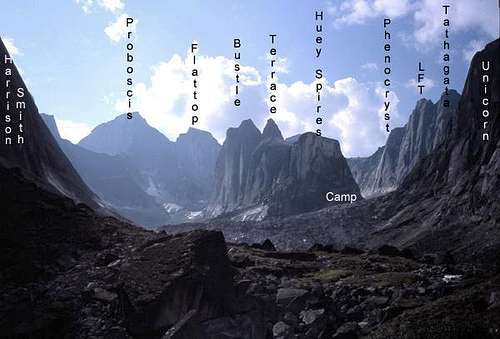
The names of the major peaks in the "Cirque of the Unclimbables". This is the first view you get of the Cirque on the hike in. The "LFT" is the Lotus Flower Tower.
Most of the parties come into the Cirque to climb the Lotus Flower Tower as their first goal - once they do that, anything else is gravy. There are many other climbs in the Cirque, but most require some type of aid or are very hard. Don't let this discourage you - often the aid is only through short (often wet) sections. Unicorn Peak contains a 5.9 climb that is well worth doing.
There is a decent written on-line guide to the climbs in the Cirque - it is a must have for climbers entering the area. It can be found on the following link - Online Guide to the Cirque of the Unclimbables.
My trip report from the Cirque also provides good info on climbing the Lotus Flower Tower.
A Reality Check
Having sung the praises of the Cirque for a number of pages now I would be remiss not to point out a few things:
This area has active rock-fall - I'm not kidding here people; almost every single day we were there, we witnessed or heard large rock falls. On the day we climbed LFT, our ropes that we had left fixed, had been chopped by a huge rock that was leaning up against the bottom of the climb only the day before. The other party that was in the Cirque when we were there had to leave due to a serious arm injury caused by natural rock fall.
The area is remote - Even now with a satellite phone in camp (something I didn't have when we were there), it still may only provide a false sense of security. If something does go wrong, even in a perfect scenario, you're looking at hours before you would be able to receive any medical care.


